The Role of Synthetic Root Exudates in Modulating Soil Hydraulic Properties and Strengths Under Temperature Variations
Abstract
1. Introduction
2. Materials and Methods
2.1. Soil and Synthetic Root Exudate
2.2. Soil Core Preparation
2.3. Measurement of Soil Hydraulic Properties
2.4. Measurement of Soil Mechanical Properties
2.5. Measurement of Soil Organic Carbon and Statistical Analysis
3. Results
3.1. Soil Water Retention Capacity
3.2. Soil Mechanical Properties
3.3. Soil Organic Carbon Changes
4. Discussion
5. Conclusions
Author Contributions
Funding
Data Availability Statement
Conflicts of Interest
References
- Bais, H.P.; Weir, T.L.; Perry, L.G.; Gilroy, S.; Vivanco, J.M. The Role of Root Exudates in Rhizosphere Interactions with Plants and Other Organisms. Annu. Rev. Plant Biol. 2006, 57, 233–266. [Google Scholar] [CrossRef] [PubMed]
- Batista, A.M.; Pessoa, T.N.; Putti, F.F.; Andreote, F.D.; Libardi, P.L. Root Influences Rhizosphere Hydraulic Properties through Soil Organic Carbon and Microbial Activity. Plants 2024, 13, 1981. [Google Scholar] [CrossRef] [PubMed]
- Wang, H.; Zhang, K.; Gan, L.; Liu, J.; Mei, G. Expansive Soil-Biochar-Root-Water-Bacteria Interaction: Investigation on Crack Development, Water Management and Plant Growth in Green Infrastructure. Int. J. Damage Mech. 2021, 30, 595–617. [Google Scholar] [CrossRef]
- Indoria, A.K.; Sharma, K.L.; Reddy, K.S. Hydraulic Properties of Soil under Warming Climate. In Climate Change and Soil Interactions; Elsevier LTD.: Amsterdam, The Netherlands, 2020; ISBN 9780128180327. [Google Scholar]
- Rajamanthri, K.; Jotisankasa, A.; Aramrak, S. Effects of Chrysopogon Zizanioides Root Biomass and Plant Age on Hydro-Mechanical Behavior of Root-Permeated Soils. Int. J. Geosynth. Gr. Eng. 2021, 7, 1–13. [Google Scholar] [CrossRef]
- Adamczewski, R.; Kaestner, A.; Zarebanadkouki, M. Rhizosphere Hydraulic Regulation in Maize: Tailoring Rhizosphere Properties to Varying Soil Textures and Moistures. Plant Soil 2024, 22, 1–4. [Google Scholar] [CrossRef]
- Oleghe, E.; Naveed, M.; Baggs, L.; Hallett, P. Interacting Effects of Root Exudate Compounds and δ 13C-Barley Shoot Residue on Micro-Mechanical Behaviour of Soil Measured by Rheometry. ESS Open Arch. 2022. [Google Scholar] [CrossRef]
- Zhang, W.; Gao, W.; Whalley, W.R.; Ren, T. Physical Properties of a Sandy Soil as Affected by Incubation with a Synthetic Root Exudate: Strength, Thermal and Hydraulic Conductivity, and Evaporation. Eur. J. Soil Sci. 2021, 72, 782–792. [Google Scholar] [CrossRef]
- Shi, X.; Qin, T.; Yan, D.; Tian, F.; Wang, H. A Meta-Analysis on Effects of Root Development on Soil Hydraulic Properties. Geoderma 2021, 403, 115363. [Google Scholar] [CrossRef]
- Lu, J.; Zhang, Q.; Werner, A.D.; Li, Y.; Jiang, S.; Tan, Z. Root-Induced Changes of Soil Hydraulic Properties—A Review. J. Hydrol. 2020, 589, 125203. [Google Scholar] [CrossRef]
- Proctor, C.; He, Y. Modeling Root Exudate Accumulation Gradients to Estimate Net Exudation Rates by Peatland Soil Depth. Plants 2021, 10, 106. [Google Scholar] [CrossRef]
- Jakoby, G.; Rog, I.; Megidish, S.; Klein, T. Enhanced Root Exudation of Mature Broadleaf and Conifer Trees in a Mediterranean Forest during the Dry Season. Tree Physiol. 2020, 40, 1595–1605. [Google Scholar] [CrossRef] [PubMed]
- Dekker, L.W.; Ritsema, C.J. How Water Moves in a Water Repellent Sandy Soil: 1. Potential and Actual Water Repellency. Water Resour. Res. 1994, 30, 2507–2517. [Google Scholar] [CrossRef]
- Gao, W.; Ren, T.; Bengough, A.G.; Auneau, L.; Watts, C.W.; Whalley, W.R. Predicting Penetrometer Resistance from the Compression Characteristic of Soil. Soil Sci. Soc. Am. J. 2012, 76, 361–369. [Google Scholar] [CrossRef]
- Moraes, M.; Debiasi, H.; Franchini, J.; Bonetti, J.; Levien, R.; Schnepf, A. Leitner Mechanical and Hydric Stress Effects on Maize Root System Development at Different Soil Compaction Levels. Front. Plant Sci. 2019, 10, 1–18. [Google Scholar] [CrossRef]
- Chenu, C.; Roberson, E.B. Diffusion of Glucose in Microbial Extracellular Polysaccharide as Affected by Water Potential. Soil Biol. Biochem. 1996, 28, 877–884. [Google Scholar] [CrossRef]
- Choudhury, B.U.; Ferraris, S.; Ashton, R.W.; Powlson, D.S.; Whalley, W.R. The Effect of Microbial Activity on Soil Water Diffusivity. Eur. J. Soil Sci. 2018, 69, 407–413. [Google Scholar] [CrossRef]
- Naveed, M.; Brown, L.K.; Raffan, A.C.; George, T.S.; Bengough, A.G.; Roose, T.; Sinclair, I.; Koebernick, N.; Cooper, L.; Hallett, P.D. Rhizosphere-Scale Quantification of Hydraulic and Mechanical Properties of Soil Impacted by Root and Seed Exudates. Vadose Zone J. 2018, 17, 1–12. [Google Scholar] [CrossRef]
- Zheng, W.; Zeng, S.; Bais, H.; LaManna, J.M.; Hussey, D.S.; Jacobson, D.L.; Jin, Y. Plant Growth-Promoting Rhizobacteria (PGPR) Reduce Evaporation and Increase Soil Water Retention. Water Resour. Res. 2018, 54, 3673–3687. [Google Scholar] [CrossRef]
- Benard, P.; Zarebanadkouki, M.; Hedwig, C.; Holz, M.; Ahmed, M.A.; Carminati, A. Pore-Scale Distribution of Mucilage Affecting Water Repellency in the Rhizosphere. Vadose Zone J. 2017, 17, 1–9. [Google Scholar] [CrossRef]
- Carminati, A.; Moradi, A.B.; Vetterlein, D.; Vontobel, P.; Lehmann, E.; Weller, U.; Vogel, H.J.; Oswald, S.E. Dynamics of Soil Water Content in the Rhizosphere. Plant Soil 2010, 332, 163–176. [Google Scholar] [CrossRef]
- Zarebanadkouki, M.; Ahmed, M.; Hedwig, C.; Benard, P.; Kostka, S.J.; Kastner, A.; Carminati, A. Rhizosphere Hydrophobicity Limits Root Water Uptake after Drying and Subsequent Rewetting. Plant Soil 2018, 428, 265–277. [Google Scholar] [CrossRef]
- Morel, J.L.; Habib, L.; Plantureux, S.; Guckert, A. Influence of Maize Root Mucilage on Soil Aggregate Stability. Plant Soil 1991, 136, 111–119. [Google Scholar] [CrossRef]
- Paterson, E.; Gebbing, T.; Abel, C.; Sim, A.; Telfer, G. Rhizodeposition Shapes Rhizosphere Microbial Community Structure in Organic Soil. N. Phytol. 2007, 173, 600–610. [Google Scholar] [CrossRef]
- Whalley, W.R.; Riseley, B.; Leeds-Harrison, P.B.; Bird, N.R.A.; Leech, P.K.; Adderley, W.P. Structural Differences between Bulk and Rhizosphere Soil. Eur. J. Soil Sci. 2005, 56, 353–360. [Google Scholar] [CrossRef]
- Bennacer, R.; Ma, X. Effect of Temperature and Surfactants on Evaporation and Contact Line Dynamics of Sessile Drops. Heliyon 2022, 8, e11716. [Google Scholar] [CrossRef]
- Fontaine, S.; Barot, S.; Barré, P.; Bdioui, N.; Mary, B.; Rumpel, C. Stability of Organic Carbon in Deep Soil Layers Controlled by Fresh Carbon Supply. Nature 2007, 450, 277–280. [Google Scholar] [CrossRef]
- Dor, M.; Assa, I.; Mishael, Y.G. The Dynamic Effect of Root Exudates on Soil Structure Aggregate Stability and Packing. EGUsphere 2023. preprint. [Google Scholar] [CrossRef]
- Baumert, V.L.; Vasilyeva, N.A.; Vladimirov, A.A.; Meier, I.C.; Kögel-Knabner, I.; Mueller, C.W. Root Exudates Induce Soil Macroaggregation Facilitated by Fungi in Subsoil. Front. Environ. Sci. 2018, 6, 140. [Google Scholar] [CrossRef]
- Gao, X.; Huang, R.; Li, J.; Wang, C.; Lan, T.; Li, Q.; Deng, O.; Tao, Q.; Zeng, M. Temperature Induces Soil Organic Carbon Mineralization in Urban Park Green Spaces, Chengdu, Southwestern China: Effects of Planting Years and Vegetation Types. Urban For. Urban Green. 2020, 54, 126761. [Google Scholar] [CrossRef]
- Lei, X.; Shen, Y.; Zhao, J.; Huang, J.; Wang, H.; Yu, Y.; Xiao, C. Root Exudates Mediate the Processes of Soil Organic Carbon Input and Efflux. Plants 2023, 12, 630. [Google Scholar] [CrossRef]
- Kuzyakova, Y.; Friedelb, J.K.; Stahr, K. Review of Mechanisms and Quantification of Priming Effects. Soil Biol. Biochem. 2000, 32, 1485–1498. [Google Scholar] [CrossRef]
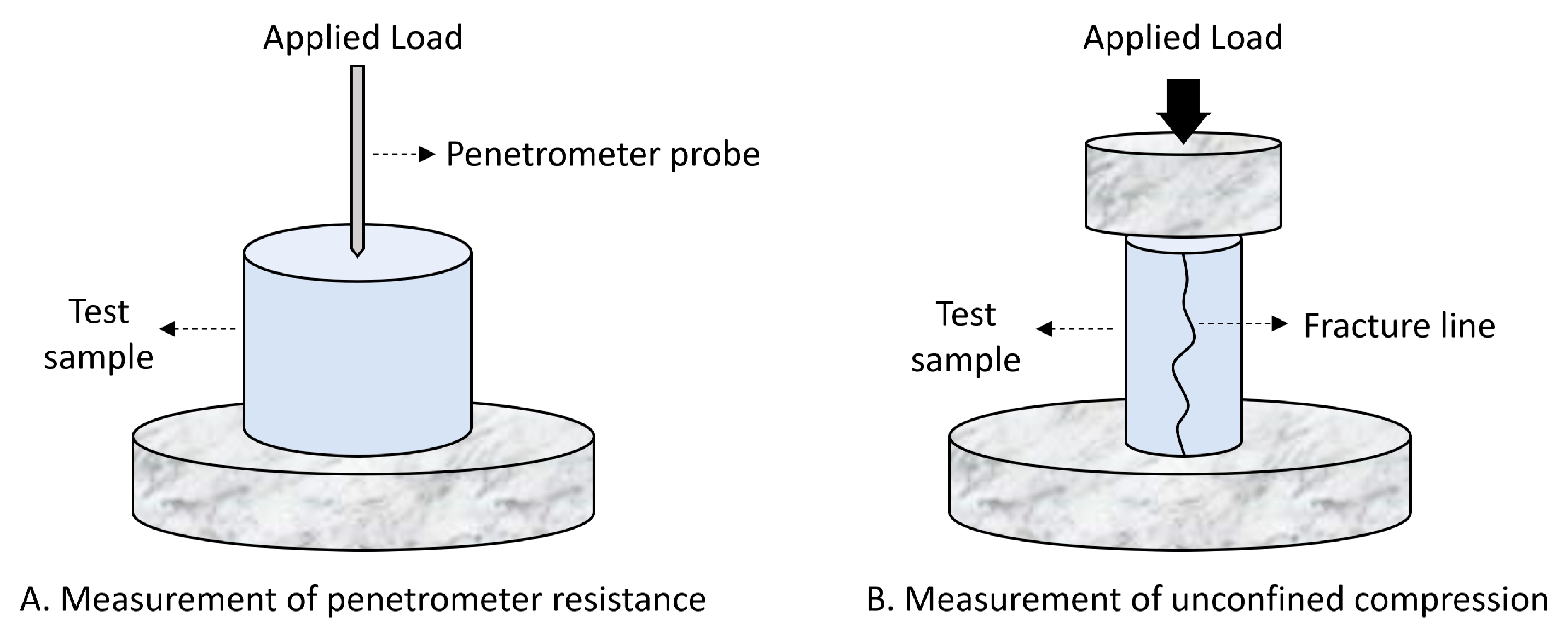
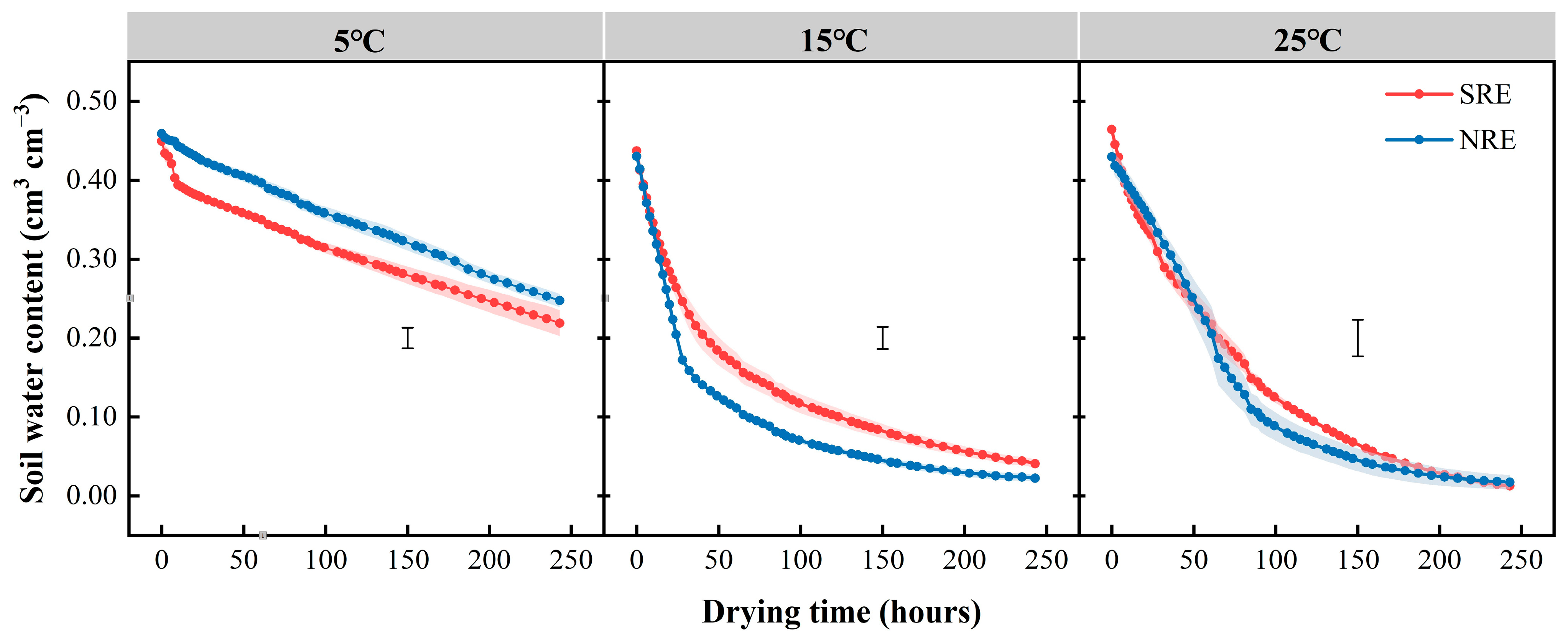
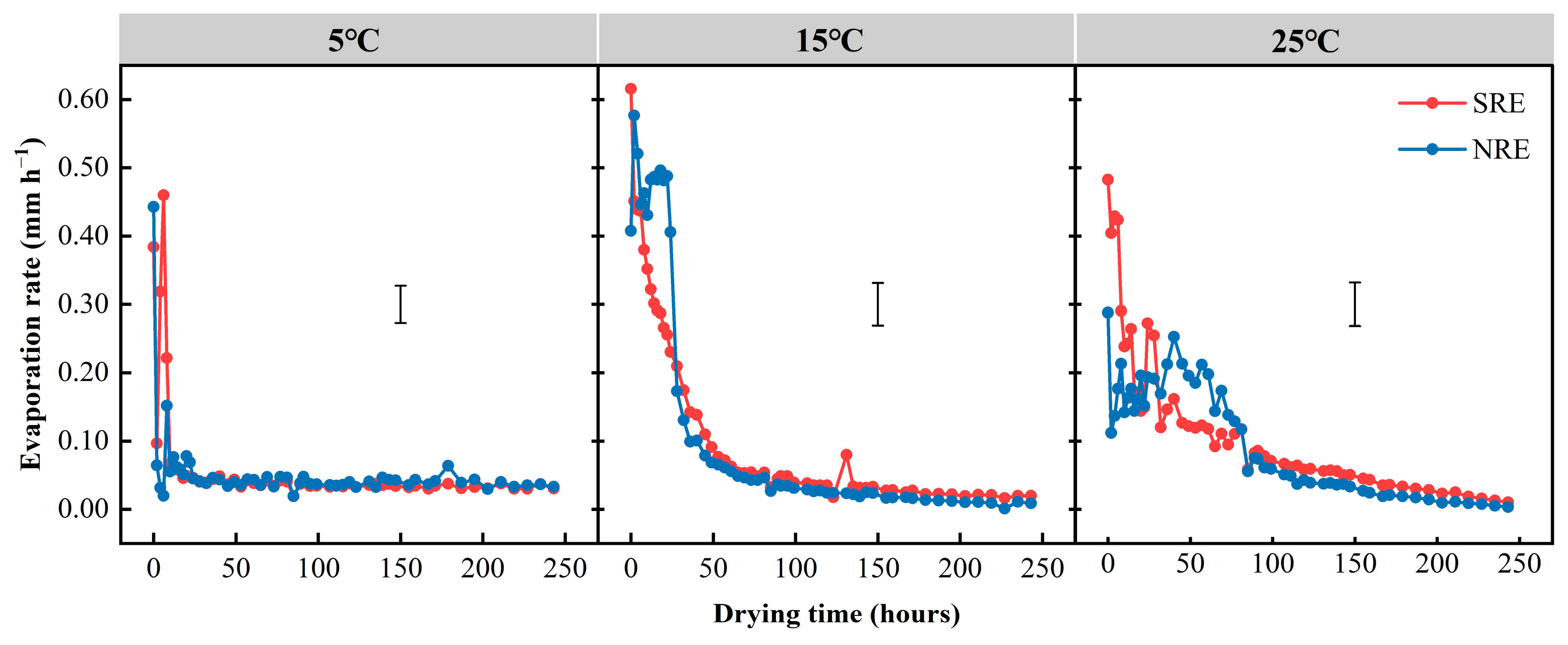

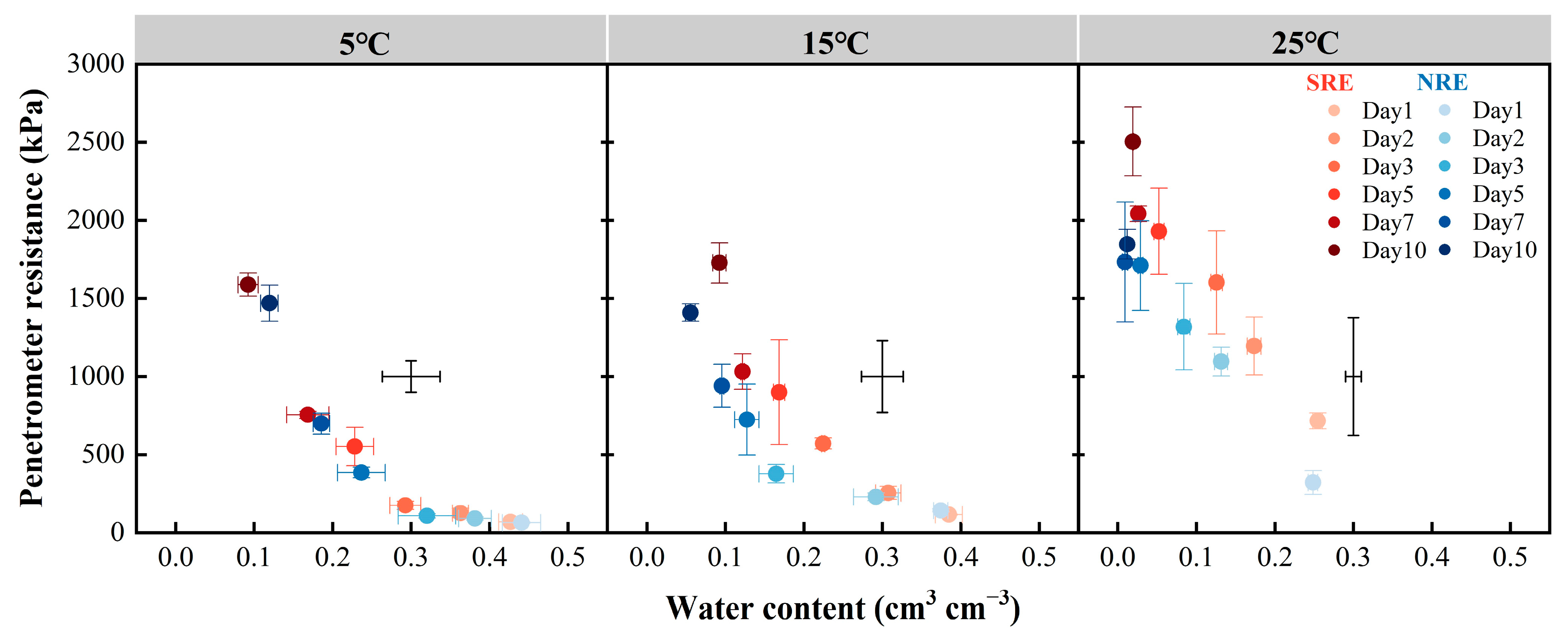
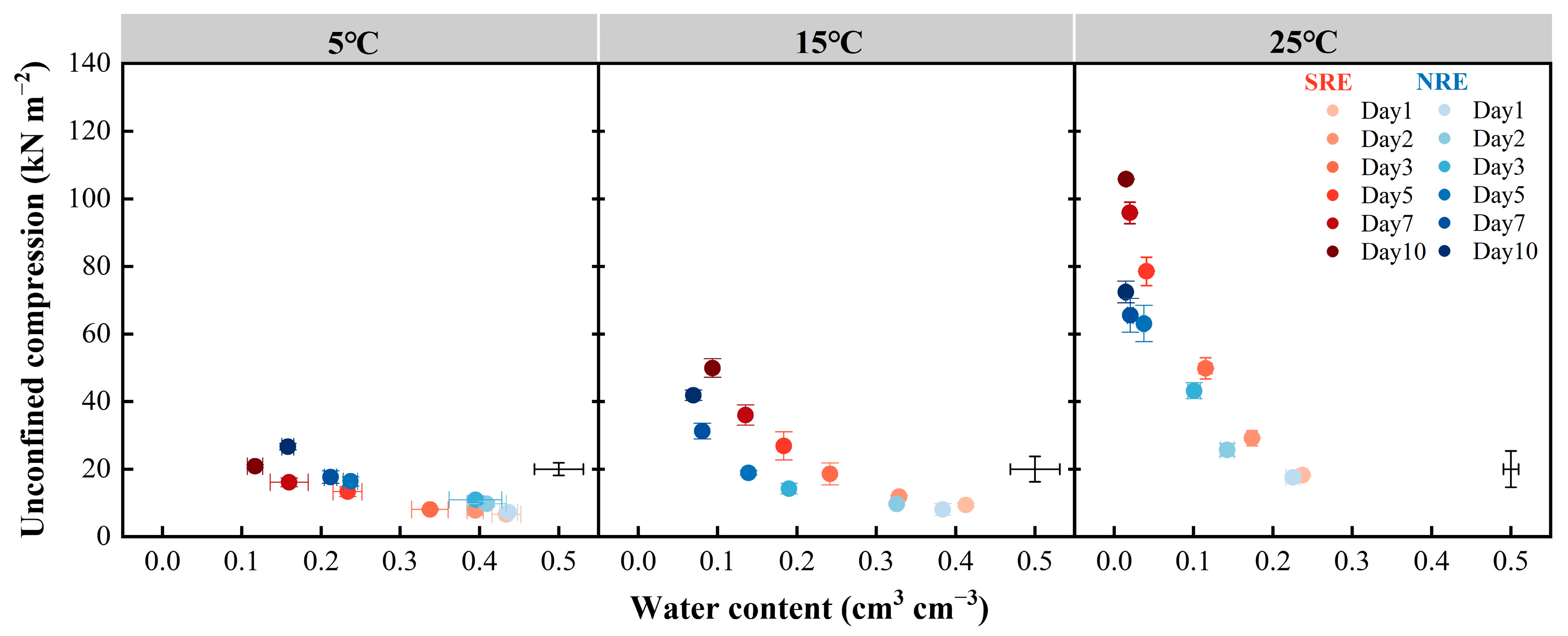
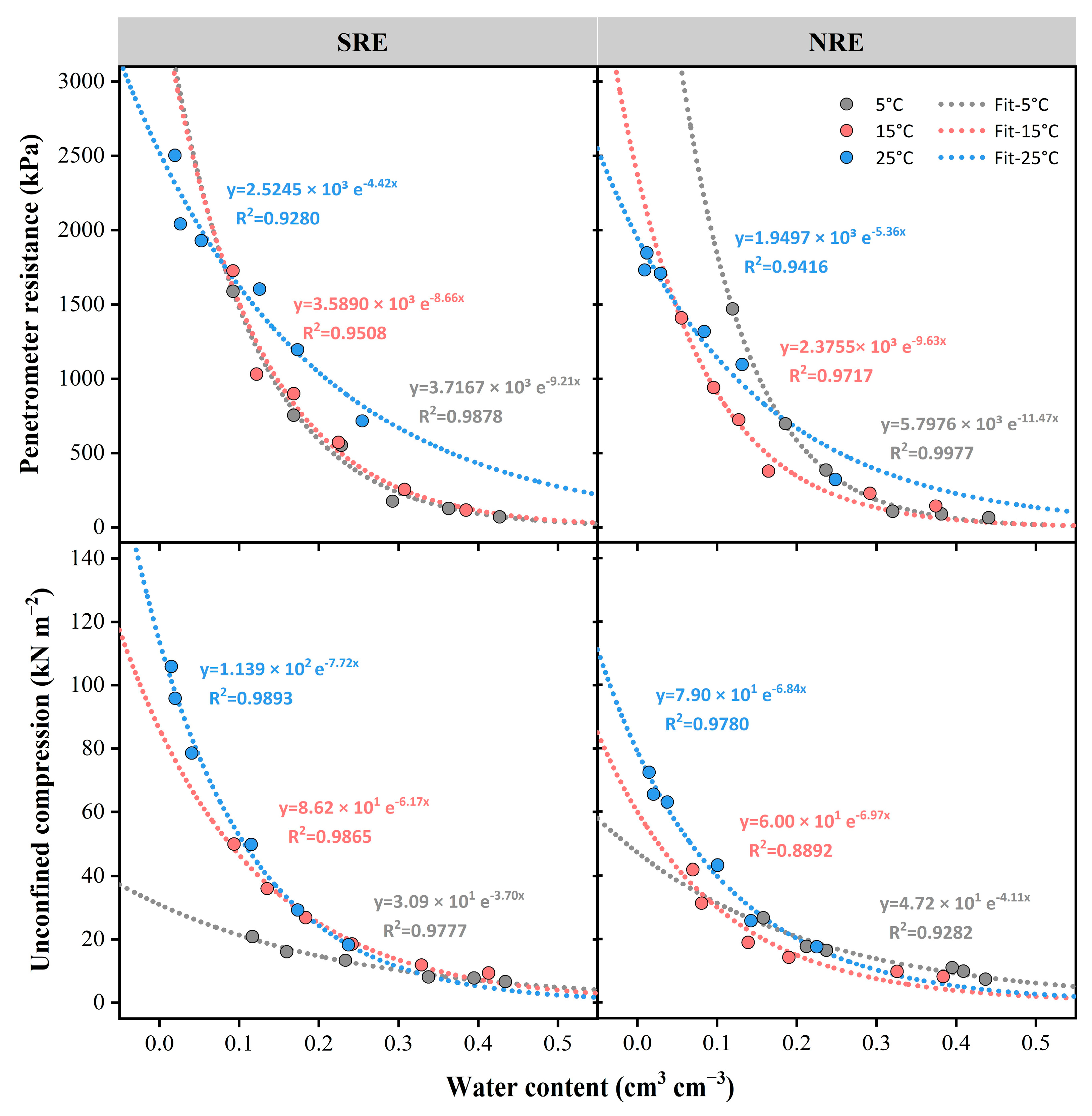
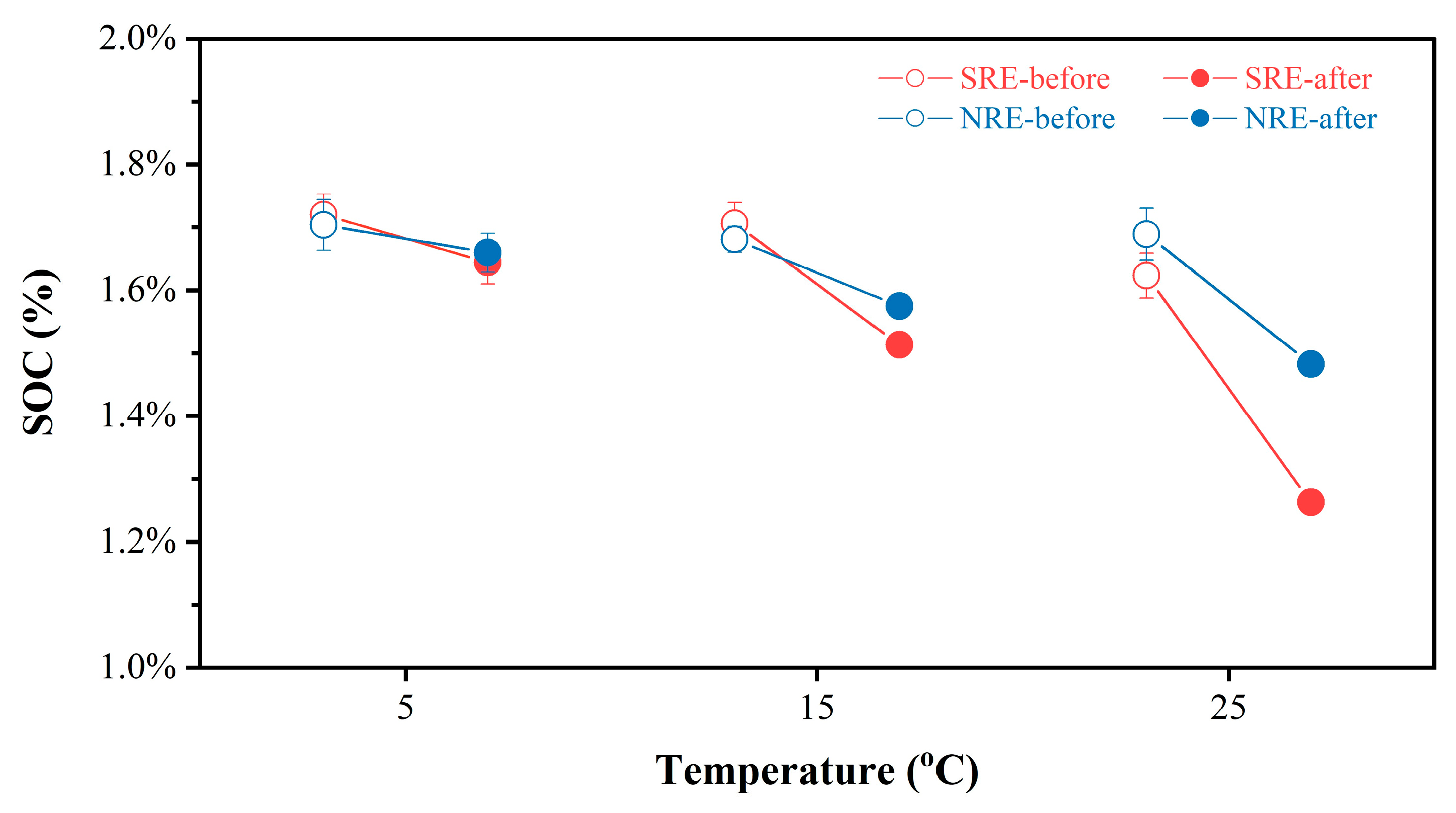
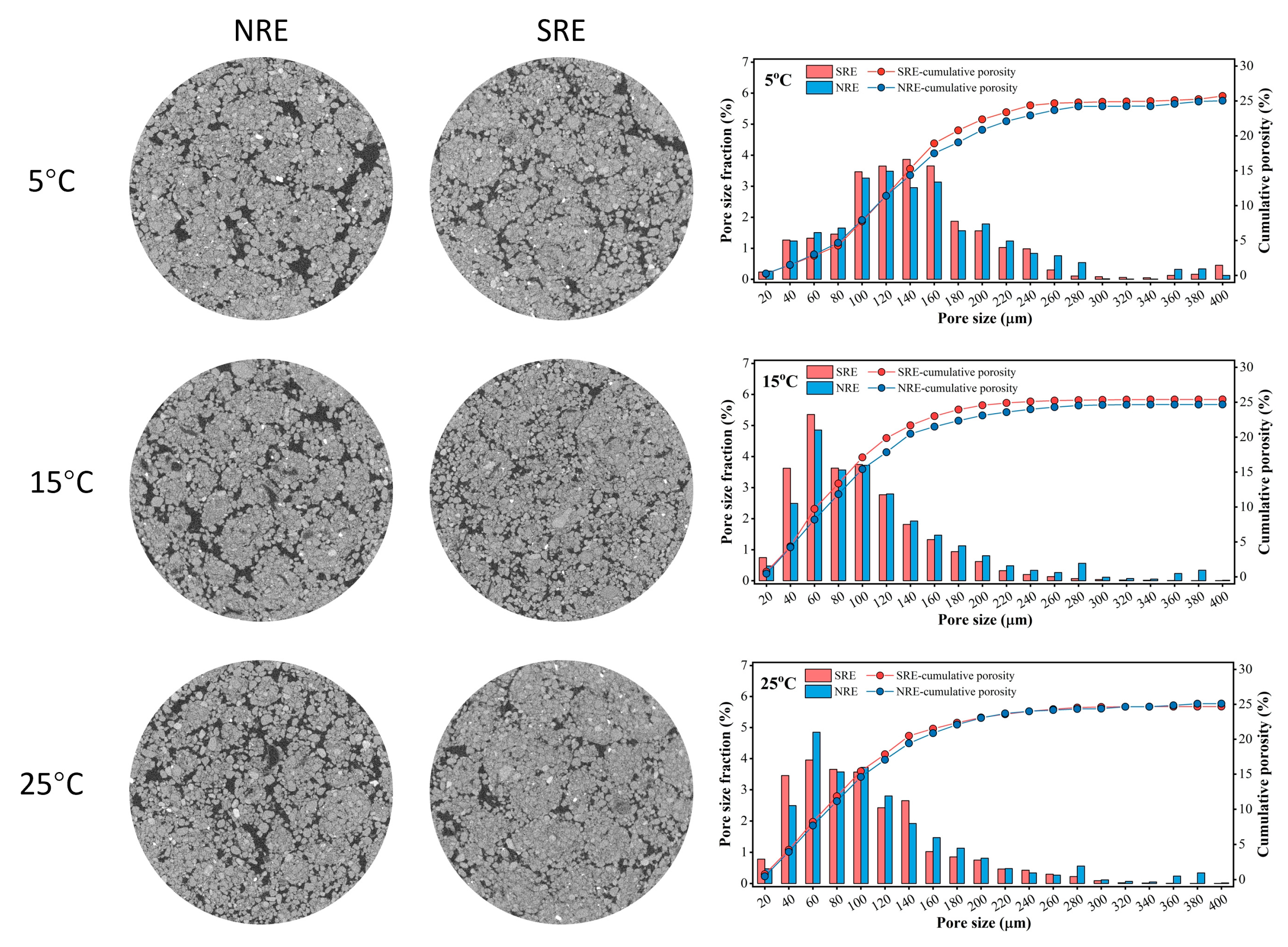
| Particle Size Distribution (%) | Texture | Soil Organic Matter (g kg−1) | Electrical Conductivity (μS cm−1) | pH | ||
|---|---|---|---|---|---|---|
| Sand | Silt | Clay | ||||
| 57.92 | 40.54 | 1.54 | Sandy Loam | 14.42 ± 1.61 | 170 ± 6.96 | 8.6 ± 0.06 |
| Degree of Water Repellency | Wettable | Slightly Water Repellent | Strongly Water Repellent | Severely Water Repellent | Extremely Water Repellent |
|---|---|---|---|---|---|
| Infiltration Time (s) | <5 | 5–60 | 60–600 | 600–3600 | >3600 |
| Root Exudate Treatment | Temperature Gradient | Water Drop Time (s) |
|---|---|---|
| SRE | 5 °C | 2.18 ± 0.42 Ac |
| 15 °C | 11.72 ± 1.27 Ab | |
| 25 °C | 34.38 ± 0.80 Aa | |
| NRE | 5 °C | 0.71 ± 0.29 Ba |
| 15 °C | 0.04 ± 0.01 Bb | |
| 25 °C | 0.06 ± 0.01 Bb |
Disclaimer/Publisher’s Note: The statements, opinions and data contained in all publications are solely those of the individual author(s) and contributor(s) and not of MDPI and/or the editor(s). MDPI and/or the editor(s) disclaim responsibility for any injury to people or property resulting from any ideas, methods, instructions or products referred to in the content. |
© 2025 by the authors. Licensee MDPI, Basel, Switzerland. This article is an open access article distributed under the terms and conditions of the Creative Commons Attribution (CC BY) license (https://creativecommons.org/licenses/by/4.0/).
Share and Cite
Bindeliya; Zhang, W.; Li, H. The Role of Synthetic Root Exudates in Modulating Soil Hydraulic Properties and Strengths Under Temperature Variations. Water 2025, 17, 1033. https://doi.org/10.3390/w17071033
Bindeliya, Zhang W, Li H. The Role of Synthetic Root Exudates in Modulating Soil Hydraulic Properties and Strengths Under Temperature Variations. Water. 2025; 17(7):1033. https://doi.org/10.3390/w17071033
Chicago/Turabian StyleBindeliya, Wencan Zhang, and Haigang Li. 2025. "The Role of Synthetic Root Exudates in Modulating Soil Hydraulic Properties and Strengths Under Temperature Variations" Water 17, no. 7: 1033. https://doi.org/10.3390/w17071033
APA StyleBindeliya, Zhang, W., & Li, H. (2025). The Role of Synthetic Root Exudates in Modulating Soil Hydraulic Properties and Strengths Under Temperature Variations. Water, 17(7), 1033. https://doi.org/10.3390/w17071033






